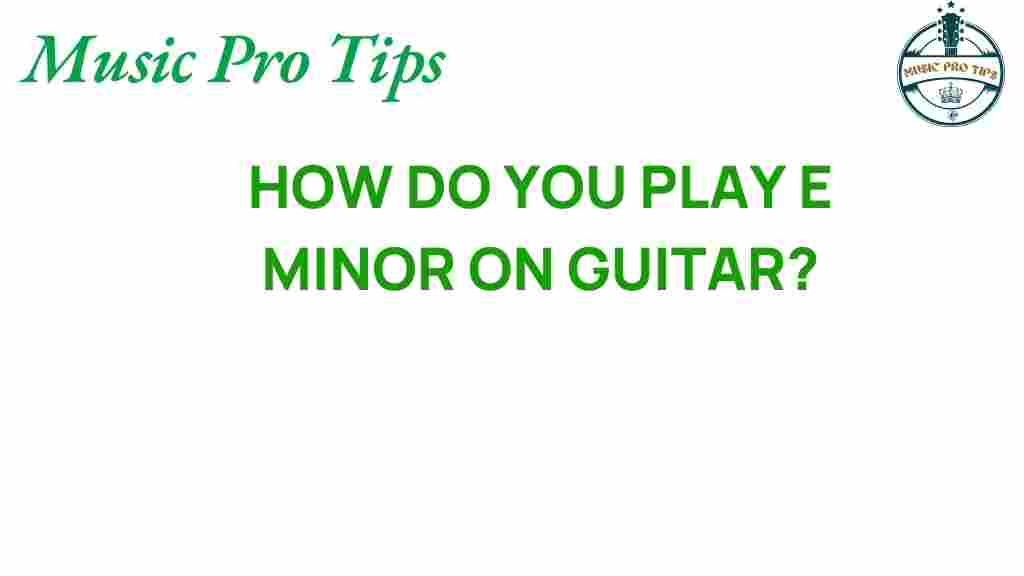Unlocking the E Minor Chord: Your Gateway to Melodic Mastery
As a beginner guitarist, exploring the world of guitar chords can seem overwhelming. However, one chord that stands out for its beauty and versatility is the E minor chord. Understanding this chord not only enhances your fretboard skills but also opens the door to countless musical expressions. In this article, we will delve into the E minor chord, explore its significance in music theory, provide essential playing techniques, and discuss effective chord progressions that can elevate your acoustic guitar playing.
Understanding the E Minor Chord
The E minor chord is one of the fundamental guitar chords that every beginner should learn. It is known for its melancholic sound and is widely used in various musical genres, making it a favorite among songwriters and performers alike.
What is E Minor?
The E minor chord is a triad consisting of three notes: E, G, and B. Here’s how it breaks down:
- E – the root note
- G – the minor third
- B – the perfect fifth
This combination of notes creates a distinct sound that evokes emotion, making it perfect for expressing feelings in music.
How to Play the E Minor Chord
Learning to play the E minor chord is straightforward. Here’s a step-by-step guide:
- Position Your Fingers: Place your second finger on the 2nd fret of the A string (5th string) and your third finger on the 2nd fret of the D string (4th string).
- Let Other Strings Ring: Allow the E string (6th string), G string (3rd string), and B string (2nd string) to ring open.
- Strum the Chord: Strum all six strings. Listen to the rich sound of the E minor chord.
Practice this chord regularly to build muscle memory and improve your overall fretboard skills.
The Importance of Music Theory
Understanding some basic music theory can significantly enhance your guitar playing. The E minor chord is part of the key of E minor, a minor scale that consists of the following notes: E, F#, G, A, B, C, and D. This scale provides a solid foundation for improvisation and songwriting.
Chord Progressions Involving E Minor
The E minor chord can be paired with various other chords to create compelling chord progressions. Here are a few popular ones:
- E minor – C major – G major – D major
- E minor – D major – A minor – B7
- E minor – G major – A minor – B7
Experimenting with these progressions will not only improve your beginner guitar skills but also enhance your musical expression.
Playing Techniques for E Minor
Once you’ve mastered the basic form of the E minor chord, it’s time to explore different playing techniques that can add depth to your sound. Here are some techniques to try:
Strumming Patterns
Varying your strumming patterns can bring a new life to the E minor chord. Here are a few patterns to practice:
- Down, down, up, up, down, up
- Down, down, down, up
- Alternate bass strumming (focus on the bass notes while strumming the chords)
Fingerpicking
Fingerpicking can add a delicate touch to your playing. To practice fingerpicking with the E minor chord:
- Use your thumb to pluck the E string.
- Use your index finger to pluck the D string.
- Use your middle finger to pluck the G string.
- Finally, use your ring finger to pluck the B string.
Combine these techniques with the E minor chord to create beautiful soundscapes.
Troubleshooting Common Issues
As you practice the E minor chord, you may encounter some common issues. Here are some troubleshooting tips:
Buzzing Strings
If you hear buzzing when you strum your E minor chord, check if:
- Your fingers are pressing down on the strings firmly enough.
- You are not touching adjacent strings with your fingers.
- Your guitar is properly tuned.
Difficulty Transitioning Between Chords
If transitioning from the E minor chord to another chord is challenging, try:
- Practicing slow transitions and gradually increasing your speed.
- Focusing on finger placement before strumming.
- Using a metronome to keep a steady tempo.
Enhancing Your Musical Expression
The E minor chord is not just a basic chord; it can evoke deep feelings and emotions. Here are some tips to enhance your musical expression using this chord:
- Experiment with Dynamics: Play softly and then gradually increase your volume to create tension and release in your music.
- Use Vibrato: Add vibrato to your notes for a more expressive sound.
- Incorporate Slides: Sliding into the chord can add a smooth transition that sounds professional.
Always remember to play from the heart; this will resonate with your audience.
Conclusion
Mastering the E minor chord is a significant step in your journey as a guitarist. By understanding its structure, practicing various techniques, and exploring different chord progressions, you can unlock a world of musical expression. Remember to be patient and consistent in your practice, and don’t hesitate to experiment with your sound.
For more resources on guitar playing and music theory, consider visiting this helpful guide. And if you’re looking for a community of fellow musicians to share your journey with, check out this forum where you can connect with others who share your passion.
Keep strumming, and let the E minor chord guide you to melodic mastery!
This article is in the category Theory and created by MusicProTips Team
